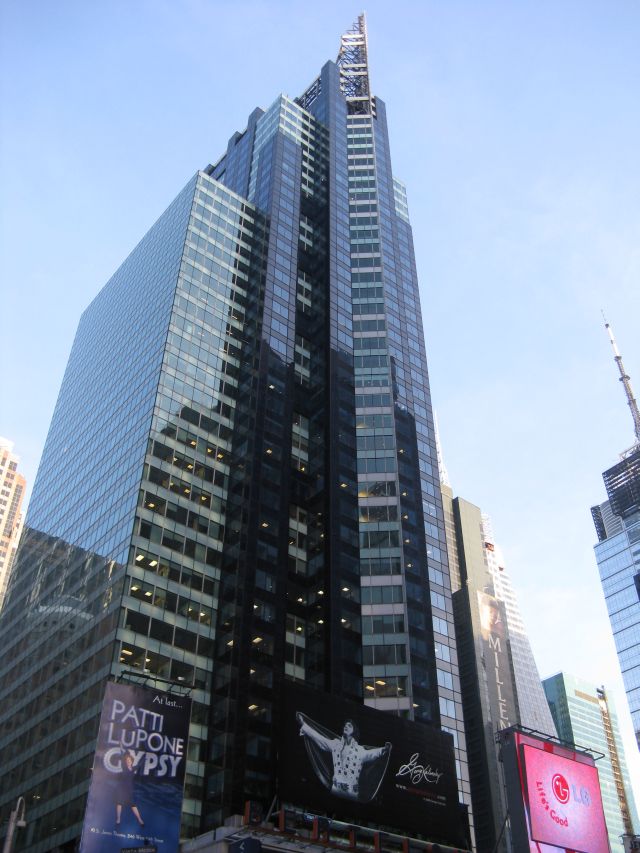
1540 Broadway
1540 Broadway, formerly the Bertelsmann Building, is a 44-story office building on Times Square in the Theater District neighborhood of Manhattan in New York City. Designed by David Childs of Skidmore, Owings & Merrill (SOM), the building was developed by Broadway State Partners, a joint venture between Bruce Eichner and VMS Development. 1540 Broadway occupies a site bounded by Broadway to the west, 45th Street to the south, and 46th Street to the north. It was originally named for its anchor tenant, German media company Bertelsmann. The building is divided into two ownership units: HSBC and Edge Funds Advisors own the office stories, while Vornado Realty Trust owns retail space at the base.
1540 Broadway
Bertelsmann Building
Office
Manhattan, New York, U.S.
1988
1990
1993
733 ft (223 m)
616 ft (188 m)
564 ft (172 m)
44
1,100,000 sq ft (100,000 m2)
1540 Broadway consists of a low base, as well as a tower section measuring 733 ft (223 m) to its spire. An outwardly projecting "prow" extends from the western side of the building. The facade is designed with large signs at the base, with a main office entrance on 45th Street. The upper stories contain a facade of blue and green glass with vertical aluminum mullions. There is a public passageway and about 150,000 sq ft (14,000 m2) of retail space at the base; the retail space was originally supposed to be part of a five-story shopping mall that was never opened. The basement formerly contained a four-screen movie theater, while the upper stories contain 860,000 sq ft (80,000 m2) of offices.
Broadway State Partners had developed 1540 Broadway on the site of Loew's State Theatre and several other buildings. Helmut Jahn initially proposed a mixed-use office, hotel, and commercial building on the site, though Childs subsequently drew up plans for an office building with retail at its base. Work started in 1988 and the building was completed in 1990, but it was completely empty for the next three years. Bertelsmann bought the building out of bankruptcy in 1992 and moved its headquarters there, opening several retail stores in the late 1990s. The Paramount Group bought the building in 2004, reselling the offices two years later to Equity Office Properties and the stores to Vornado. The offices were subsequently resold to Harry B. Macklowe in 2007, Deutsche Bank in 2008, and CBRE Group in 2009; HSBC and Edge acquired the offices in a two-part sale in 2010 and 2011.
Site[edit]
1540 Broadway is on the east side of Broadway, along Times Square between 45th Street (George Abbott Way) to the south and 46th Street to the north, in the Midtown Manhattan neighborhood of New York City.[3][4] The irregularly shaped land lot covers 38,700 sq ft (3,600 m2), with a frontage of 180 ft (55 m) on Broadway and a depth of 186.06 ft (57 m). The building wraps around another structure at the northwest corner, and the section of the building on 46th Street extends further east than the portion on 45th Street. The northern end of the building faces Duffy Square.[4]
The surrounding area is part of Manhattan's Theater District and contains many Broadway theaters.[3] On the same block are the Lyceum Theatre, the Jacqueline Kennedy Onassis High School for International Careers, and Americas Tower to the east. Other nearby buildings include the Hotel Edison and Lunt-Fontanne Theatre to the northwest; TSX Broadway, the Palace and Embassy Theatres, and the I. Miller Building to the north; 1530 Broadway, the Hudson Theatre, and the Millennium Times Square New York hotel to the south; One Astor Plaza to the southwest; and the New York Marriott Marquis hotel to the west.[4]
The site formerly contained Loew's State Theatre, built in 1921 at the address 1540 Broadway.[5][6] Loew's State Theatre had been housed within a 17-story office building prior to its demolition in 1987.[6][7] The old theater's design had complemented that of the Lyceum Theatre, a Broadway theater, immediately to the east.[8] The site had also contained several smaller buildings,[5] including a United Service Organizations (USO) recruitment center.[9]
Reception[edit]
During 1540 Broadway's construction, Karrie Jacobs wrote that the design is "a building so divided between the subdued aesthetics of premium office space and an attempt to cash in on the mythology of Times Square that it's positively schizophrenic", though she thought this quality aligned with the "craziness of Times Square itself".[16][163] According to Crain's New York magazine, the blue-and-green glass facade gave the tower a "plaid" look.[26] Claudia Deutsch of The New York Times described the building's "green tint and striking prow" as "highlighting its million square feet of bulk".[55] Eve M. Kahn of The Wall Street Journal said: "Skidmore Owings & Merrill's 1540 Broadway [...] cannot relate to its neighbors", part of a trend in which "all the area's new construction clashes violently" with Times Square's existing architecture.[164] Kahn particularly lamented the empty retail space as "most bombastic and now most miserable" out of all the new projects on Times Square.[164]
When 1540 Broadway was completed, architect and writer Robert A. M. Stern described its initial lack of tenants as "a perfect metaphor for the excesses of real estate in the 1980s".[16] The building's bankruptcy led journalist Jerry Adler to publish a book about the building in 1993, entitled High Rise: How 1,000 Men and Women Worked Around the Clock for Five Years and Lost $200 Million Building a Skyscraper.[71][165][166] Adler's book had been possible because, unlike other developers of unsuccessful buildings, Eichner and his partners were willing to speak publicly about 1540 Broadway.[71][165] David W. Dunlap wrote of the book: "On learning about the coincidences, accidents and sheer chance that shaped [1540 Broadway], one marvels that anything got built at all."[71]